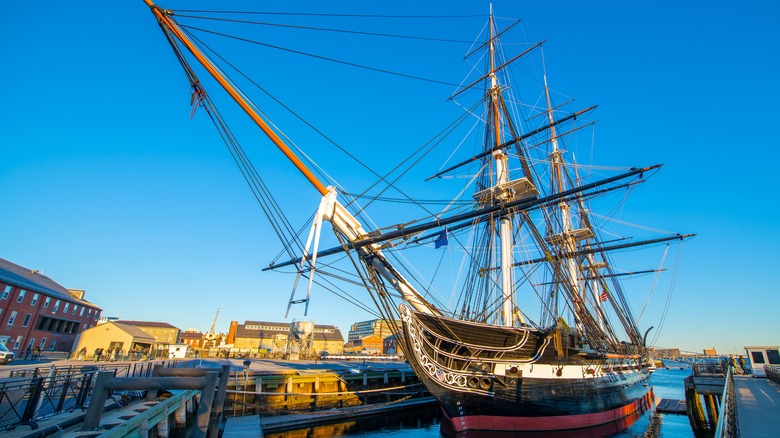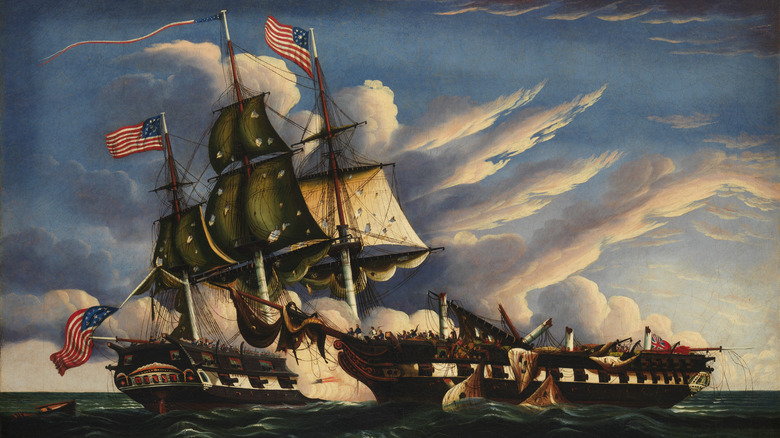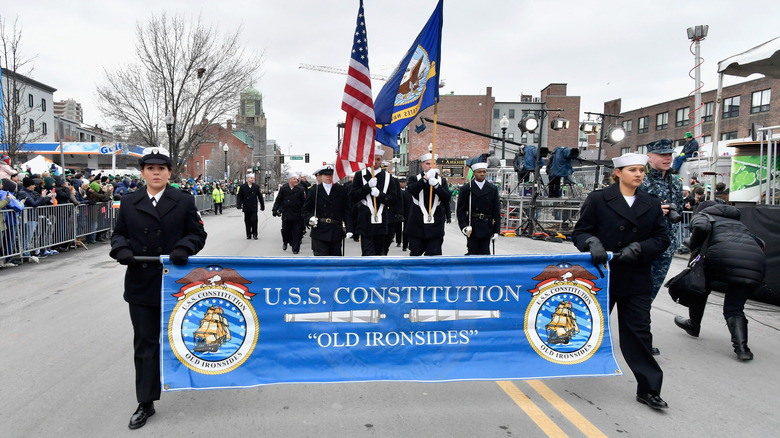How The USS Constitution Earned The Name Old Ironsides
The USS Constitution is a triple-masted wooden heavy frigate, and it's the oldest commissioned warship still afloat. The ship first launched in 1797 as the first of six frigates commissioned for the U.S. Navy ((PAGE 6-8)). Unlike other contemporary frigates, the Constitution and its sister ships were built tougher, larger, and more heavily armed. Throughout her history, the Constitution participated in numerous conflicts, including the War of 1812, where it earned the nickname "Old Ironsides" during a battle against the HMS Guerriere.
The USS Constitution sailed from Boston on August 2, 1812, under the command of Captain Isaac Hull. The vessel sailed several hundred miles off the coast of Nova Scotia, where it came face to face with the British frigate HMS Guerriere. Captain James Richard Dacres commanded that ship, and their engagement began an intense firefight soon after spotting one another on the afternoon of August 19. The ships came in close and intertwined, leading to a fierce firefight.
As the Guerriere fired its cannons, a sailor aboard the Constitution remarked, "Huzza! Her sides are made of iron! See where the shot fell out!" The Guirrere's cannonballs literally slammed into the Constitution's strong wooden hull and fell into the water. This made the Constitution far more resilient than its British enemy. After trading several volleys of cannonballs over about an hour and moving apart, the Guirrere was too damaged to continue, leading Captain Dacres to offer his surrender, and the Americans burned his ship the following day.
A new nickname is earned
The Constitution's victory came at a time when the British were the dominant naval power in the world. The United States Navy was new, untested, and woefully ill-equipped to take on British ships — at least, that's what everyone thought. When the Constitution defeated the Guirrere in a confrontation many believed to be one-sided, the Navy proved its worth. It began a series of successful engagements that helped make the U.S. Navy a worldwide superpower.
Granted, that was a long time coming, but it started with the Constitution, so it's an important ship in American naval history. After the victory, the country celebrated Captain Hull and his men throughout the nascent nation. His vessel was dubbed "Old Ironsides" to commemorate the Constitution's ability to shake off the Guirrere's cannonballs. This cemented Old Ironsides as an important historical vessel and gave the U.S. a desperately needed win.
The Constitution remained in service for several decades, but despite its thick hull and combat successes, it eventually found itself outpaced by modern advancements. By the mid-19th century, the Constitution was a relic of a bygone age. It became a training vessel, and the U.S. Navy used it as such during the American Civil War. Eventually, the government saw its worth and paid hefty sums to rebuild the ship to its 1812 configuration, which is how Old Ironsides exists today.
The USS Constitution continues to operate centuries after commissioning
While she currently operates as a museum ship and has been since 1907, the Constitution remains active. She sailed under her own power to celebrate her 200th birthday and can sail at any time should the need arise. Granted, she'd be something of a last resort for any combat actions, as her current mission is to educate the public about the ship and the Navy's history.
To this day, the Constitution maintains a crew of 75 enlisted sailors and three commissioned officers, all of whom are taken from the U.S. Navy's active duty ranks. An assignment to the Constitution is a mark of pride and distinction, as it's a special duty few enjoy throughout their careers. When she was first commissioned, nobody called the Constitution "Old Ironsides," but that's the name she bears to this day.
Old Ironsides' combat victory against the HMS Guerriere is a watershed moment in naval history, as it marked an important change in global military power that saw the degradation of the United Kingdom's global navally-supported empire and the rise of U.S. actions on the world stage.


